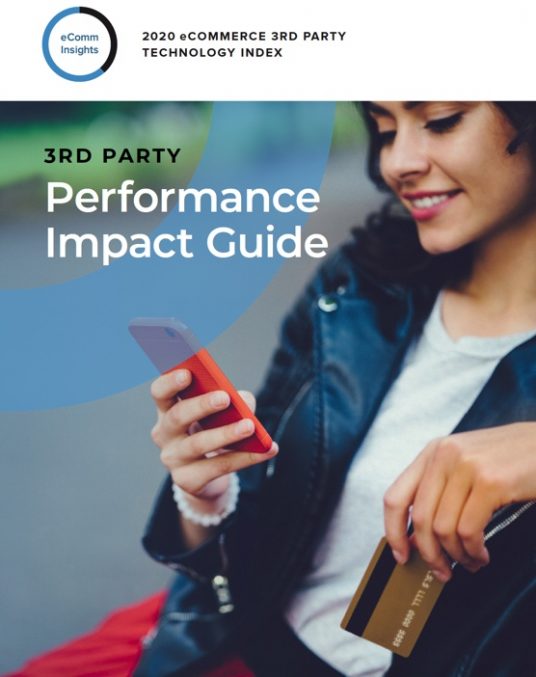
Yottaa Publishes 2020 eCommerce 3rd Party Technology Performance Index
Third Annual Index Rates the Best and Worst Performing eCommerce 3rd Parties
Waltham, MA—October 20, 2020—Yottaa, Inc., the leading cloud platform for accelerating eCommerce, today announced the publication of the latest version of the company’s index on the performance of 3rd party technologies used on online retail and brand websites. The “2020 eCommerce 3rd Party Technology Index” is designed to help retailers research new technologies for their sites and understand the impact 3rd parties can have on overall site performance.
The pressure for retail and D2C brands to move to digital has been intense over the past year. With store closures and shoppers not wanting to leave their homes, brands that hadn’t previously prioritized their digital experience took a huge hit. It’s clear that optimizing the performance of digital channels is now a “must have” for retailers to succeed in this environment. As consumers demand a richer and more personalized experience while shopping online, more and more eCommerce 3rd parties are being released to empower retailers to meet those demands. Leading brands understand that adding numerous 3rd parties, such as live chat, personalization, and customer reviews, is the only way to achieve the online experience today’s consumers expect. But those 3rd party technologies have also been proven to significantly slow down page load times.
The 2020 eCommerce 3rd Party Technology Index examines the performance impact of close to 500 of the most widely adopted 3rd parties. The data in this report was collected over the course of a month (September 2020) from over 1,500 eCommerce sites using Yottaa’s digital experience optimization solutions. As part of the its platform, Yottaa’s 3rd Party Knowledge Base is a comprehensive repository of 3rd party data that grows with every page view, adding hundreds of millions of real shopper data points every day. Through this knowledge base, Yottaa has deep visibility into site performance data from almost 1,000 3rd parties used by its customers. The Yottaa platform also detects site performance violations of individual 3rd parties. These violations are used to create Performance Impact Ratings (PIR) for each 3rd party in the index.
“As a solution revolutionizing how consumers experience digital commerce, we face significant and unique page weight challenges,” said Cait Porte, SVP Customer Experience, Zmags. “Using the 3rd Party Index as a guide, we prioritized performance and worked with the Yottaa team to optimize load speed on our interactive content. This has resulted in faster, more consistent loading time and an improved PIR score.”
Below are some of the key findings from the 2020 3rd Party Index:
- Year-over-year analysis – With this third annual publication of the index, Yottaa is able to compare the performance of tracked 3rd parties year-over-year. Some 3rd parties that were labeled as top violators last year took feedback from the index and improved significantly. Some did not.
- Most improved 3rd parties – It takes hard work and effort for 3rd parties to improve from one level to another. Typically, this is done with an internal vendor roadmap focused on improving the performance impact their technology is having on their customers’ sites. For example, Zmags, a Content Management System vendor, put in a massive effort to speed up the page load time of its product, and, as a result, significantly improved its performance rating in the 2020 index.
- Percentage of site a 3rd party is running on – In addition to ranking the performance of individual 3rd parties, the 2020 index also reports the percentage of a site on which a 3rd party is running. This data demonstrates that retailers frequently have 3rd parties running across their entire sites, potentially causing site delays and increasing security risks. For example, a Payment Processing 3rd party should report a very low percentage, as it should only be on the checkout page. This was often not the case.
- Top 20 leaderboard – One result that stands out in this year’s leaderboard is that Google 3rd parties account for 8 of the 20 technologies used most by retailers. This number was high last year as well, indicating that retailers value the benefits of using Google technology. We also found that some notable 3rd parties that made this list last year have completely fallen off this year’s chart.
“With a huge portion of shopping today being conducted via digital channels, brands need to use many 3rd party features on their sites to deliver shoppers differentiated, highly-personalized, and engaging experiences,” said Rich Stendardo, CEO of Yottaa. “Now it its third iteration, the 2020 eCommerce 3rd Party Index analyzes performance across billions of real shopper page views, and has become the source of truth for retailers and D2C brands to evaluate the impact 3rd parties have on site performance and shopper experience.”
Click here to download the 2020 eCommerce 3rd Party Technology Index.
About Yottaa
Leading brands such as Ann, Inc., Carter’s, Express, Lands’ End, Mattress Firm, Nutrisystem, Ralph Lauren, and Samsonite rely on Yottaa to accelerate, optimize, and control 3rd party eCommerce technologies, high resolution images, and other website elements, resulting in superior customer experiences, up to 60% faster web performance, and up to 20% increases in online conversion. To learn more about how Yottaa can optimize every page load on your eCommerce site and increase conversions, please visit www.yottaa.com or follow @yottaa on Twitter.
Media Contact:
Tedd Rodman
617-239-9024
t.rodman@yottaa.com
###
